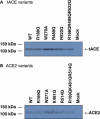Residues affecting the chloride regulation and substrate selectivity of the angiotensin-converting enzymes (ACE and ACE2) identified by site-directed mutagenesis
- PMID: 19021774
- PMCID: PMC7163990
- DOI: 10.1111/j.1742-4658.2008.06733.x
Residues affecting the chloride regulation and substrate selectivity of the angiotensin-converting enzymes (ACE and ACE2) identified by site-directed mutagenesis
Abstract
Angiotensin-converting enzyme (ACE) and its homologue angiotensin-converting enzyme 2 (ACE2) are critical counter-regulatory enzymes of the renin-angiotensin system, and have been implicated in cardiac function, renal disease, diabetes, atherosclerosis and acute lung injury. Both ACE and ACE2 have catalytic activity that is chloride sensitive and is caused by the presence of the CL1 and CL2 chloride-binding sites in ACE and the CL1 site in ACE2. The chloride regulation of activity is also substrate dependent. Site-directed mutagenesis was employed to elucidate which of the CL1 and CL2 site residues are responsible for chloride sensitivity. The CL1 site residues Arg186, Trp279 and Arg489 of testicular ACE and the equivalent ACE2 residues Arg169, Trp271 and Lys481 were found to be critical to chloride sensitivity. Arg522 of testicular ACE was also confirmed to be vital to the chloride regulation mediated by the CL2 site. In addition, Arg514 of ACE2 was identified as a residue critical to substrate selectivity, with the R514Q mutant, relative to the wild-type, possessing a fourfold greater selectivity for the formation of the vasodilator angiotensin-(1-7) from the vasoconstrictor angiotensin II. The enhancement of angiotensin II cleavage by R514Q ACE2 was a result of a 2.5-fold increase in V(max) compared with the wild-type. Inhibition of ACE2 was also found to be chloride sensitive, as for testicular ACE, with residues Arg169 and Arg514 of ACE2 identified as influencing the potency of the ACE2-specific inhibitor MLN-4760. Consequently, important insights into the chloride sensitivity, substrate selectivity and inhibition of testicular ACE and ACE2 were elucidated.
Figures





References
-
- Inagami T (1994) The renin–angiotensin system. Essays Biochem 28, 147–164. - PubMed
-
- Corvol P, Williams TA & Soubrier F (1995) Peptidyl dipeptidase A: angiotensin I‐converting enzyme. Methods Enzymol 248, 283–305. - PubMed
-
- Tipnis SR, Hooper NM, Hyde R, Karran E, Christie G & Turner AJ (2000) A human homolog of angiotensin‐converting enzyme. Cloning and functional expression as a captopril‐insensitive carboxypeptidase. J Biol Chem 275, 33238–33243. - PubMed
-
- Zisman LS, Keller RS, Weaver B, Lin Q, Speth R, Bristow MR & Canver CC (2003) Increased angiotensin‐(1–7)‐forming activity in failing human heart ventricles. Evidence for up‐regulation of the angiotensin‐converting enzyme homologue ACE2. Circulation 108, 1707–1712. - PubMed
-
- Ishiyama Y, Gallagher PE, Averill DB, Tallant EA, Brosnihan KB & Ferrario CM (2004) Upregulation of angiotensin‐converting enzyme 2 after myocardial infarction by blockade of angiotensin II receptors. Hypertension 43, 970–976. - PubMed
Publication types
MeSH terms
Substances
Grants and funding
LinkOut - more resources
Full Text Sources
Other Literature Sources
Molecular Biology Databases
Miscellaneous

